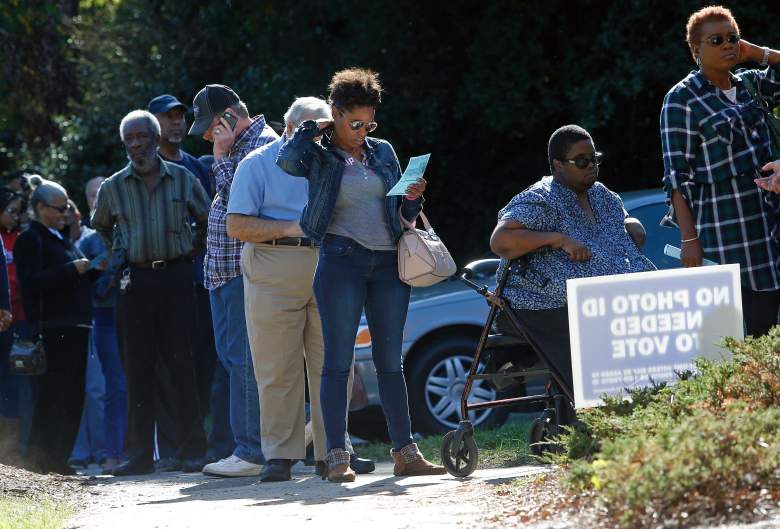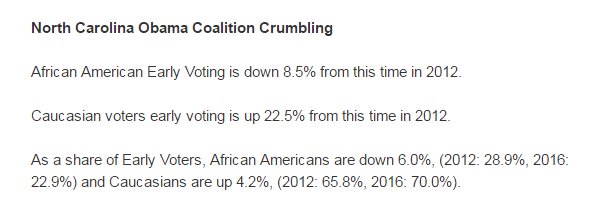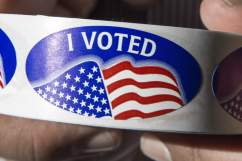
North Carolina early voters wait in line to cast their ballots. (Getty)
Donald Trump pulled off his victory by slim margins in three rust-belt states. Did voter suppression and voter ID play any role in Trump’s electoral college victory?
There were voter suppression controversies in some of the states that determined the presidency, including Wisconsin, Ohio, and North Carolina.
Wisconsin turnout plummeted to its lowest point in 20 years in the first election where voters were required to present an ID to vote. Trump won the typically presidential blue state by just over 27,000 votes. Wisconsin’s elections chief told The Milwaukee Journal Sentinel he believed voter ID depressed turnout in high poverty wards, as the City of Milwaukee saw 41,000 fewer votes.

Wisconsin Governor Scott Walker introduces Donald Trump at the beginning of the rally. Upon taking the stage, Trump said that Walker has done a “fantastic job” for the state of Wisconsin. (Getty)
After the Supreme Court struck down part of the Voting Rights Act in 2013, many polling places were closed across the country. According to the Texas Tribune, five of the top 10 counties nationwide for closing polling places were in Texas (where Clinton had a late surge but Trump easily carried in the end). The court ruling invalidated a provision that made it tougher for some states to enact laws that restrict voting.
A November 2016 report by the Leadership Conference Education Fund found that voters had “at least 868 fewer places to cast ballots in the 2016 presidential election than they did in past elections, a 16 percent reduction,” a finding it attributed to widespread polling place closings since the Supreme Court decision. Many of those were in Arizona, a battleground state that Clinton lost but turned so competitive the AP did’t call it until November 10.
The New York Times said courts had invalidated Voter ID laws in Texas and North Carolina before the election. However, some remained.
There are many complex reasons Trump won, of course, and, although his margins of victory were slim in some key states, his victory was broad in that it encompassed enough states to make it unlikely a challenge could be brought on voter suppression issues that could change the outcome.
The bottom line: In state after state, Clinton failed to turn out her core constituencies, especially in Democratic areas like Milwaukee, with large African-American populations. Meanwhile, Trump flipped rural areas in multiple states, appealing to white working class voters (women) who lacked college degrees. For example, in Wisconsin, he flipped a series of Wisconsin counties along the Mississippi River valley that are dominated by blue-collar, working-class whites. In that state, he under-performed Mitt Romney in more populous Republican areas, and Clinton didn’t turn out her voters in urban areas enough.
Wisconsin is not the only battleground state with election controversies. North Carolina was riven with controversies over alleged voter suppression in the days before the election, as accusations flew over declining polling places and purged voter registration lists. In Ohio, there were concerns about absentee ballots.
Issues also mattered. Democrats lost a portion of their base, as white working class voters without college educations switched to Trump, motivated by his positions on trade, jobs, and law-and-order. Some exit polls even had Trump performing better than Mitt Romney with Latino voters.
The liberal Nation said voter suppression was the most under-covered story of the campaign, counting 14 states with new voting restrictions, including Wisconsin and Virginia. The Nation also said “there were 868 fewer polling places in states with a long history of voting discrimination, like Arizona, Texas, and North Carolina,” citing the Leadership Conference report.
Here’s what you need to know:
Polling Place Closures
The 2016 report on polling closures found that “some states have closed polling places on a massive scale. In Arizona, almost every county reduced polling places. In Louisiana, 61 percent of parishes reduced polling places. In our limited sample of Alabama counties,
67 percent closed polling places. In Texas, 53 percent of counties in our limited sample reduced voting locations.”
Of those states, Arizona was considered a battleground in the presidential election. Hillary Clinton lost the state, but it was tight enough that the Associated Press did not call Arizona for Donald Trump until November 10, a full two days after the election.
According to the report, four of the top 5 counties with the biggest reductions in polling places are in Arizona. There can be reasons for closing polling places. The report noted, “Some counties, particularly in Arizona and Texas, have consolidated polling places as part of a move to a ‘super-precinct’ or ‘vote center’ system for Election Day. Under this system, there are dramatically fewer polling places but voters from anywhere in a county can cast ballots at any of the remaining voting sites.”
Some counties claimed they needed to close polling places to comply with disability laws, said the report.
Wisconsin & Voter ID
The November election marked the first time that Wisconsin voters had to show photo IDs at the polls. What happened to turnout? It plummeted. However, it’s not clear for sure that photo ID drove all or even some of that; there could have been other factors at play, such as a general lack of enthusiasm for Hillary Clinton as a candidate and her neglect of the state (she didn’t visit it a single time after the primary).
Still, Wisconsin turnout was at a 20-year low for the 2016 presidential election, election officials told Fox 6 Milwaukee, with 66% of voters showing up. Voter distaste for the major presidential candidates lingered; three thousand people voted in the U.S. Senate race but skipped the presidential, said the television station. Statewide turnout was about 70% for the previous two presidential elections, said the TV station.
The highest statewide turnout in Wisconsin was 73% in 1994 and 1960.
The Voter ID controversy in Wisconsin has existed for years and is extremely polarized, just like the state. Republicans have argued IDs were needed to protect election integrity (and with both Houses of the Legislature in Republican control, along with the governor’s mansion, they finally got their wish.) Wisconsin lists multiple documents that people can present at the polls to comply with the law. (In contrast, voters in Michigan, which has a Voter ID law, can vote by affidavit if they don’t have required documents.)
Democrats argued Voter ID was a tactic to suppress the vote of minorities and traditional Democratic constituencies. In September, a federal judge expressed concern about allegations that “DMV personnel in the state have provided incorrect information to people who have applied for voter IDs.” The Nation reported on those allegations.
The ACLU has argued that Wisconsin’s Voter ID law is one of the “harshest” in the country and sued over the law. A district court struck down the law, but the ruling was overturned in the 7th Circuit. A federal trial court then ruled that the state needed to let people without IDs vote by affidavit, but the 7th Circuit stayed that ruling. Further legal challenges continue. The law first passed in 2011, but was hung up in legal battles. The New York Times said federal courts loosened some of the law’s requirements, such as adding to the list of documents that college students could use to vote. The Times said the law limits voters to presenting one of eight forms of identification.
Todd Allbaugh, a former GOP legislative aide, testified during the Voter ID lawsuits that he heard GOP legislators urge the passing of the law because it would help Republicans win by affecting college campuses and Democratic Milwaukee, according to The Wisconsin State Journal. A federal judge at the trial court level had called the Voter ID law a “wretched failure” designed to suppress the African-American vote in Milwaukee. The state was told to issue a valid ID to any qualified voter who applied.
There were other factors at work to explain Trump’s victory; Trump redrew the Wisconsin map. He flipped a region, the Mississippi River Valley along the western ridge of the state. That area went for Obama, but it’s full of blue-collar white working class voters upset about the economy, trade, and jobs. Trump under-performed Mitt Romney in the state’s populous “WOW” counties – the three affluent Republican counties that ring Milwaukee and which came out big for Scott Walker in previous governor’s races.
In addition, millions of dollars flooded into the state in the final week to boost the candidacy of U.S. Senator Ron Johnson, whose seat was considered critical to Republican control of the U.S. Senate. Trump also had the boosting of a Republican governor, Walker, despite Wisconsin’s presidential blue voting history.
Here’s how the numbers broke down in Wisconsin:
2016
Donald Trump 1,409,467
Hillary Clinton 1,382,210
Gary Johnson 106,442
Jill Stein 30,980
Darrell Castle (Constitution) 12,179
Monica Moorehead (Workers’ World) 1,781
Rocky de La Fuente (Independent) 1,561
Total: 2,944,620
Total two party: 2,719,677
Total third party: 205,204 (about 7%)
In contrast, in 2012:
Barack Obama: 1,613,950
Mitt Romney: 1,408,746
Gary Johnson: 20,279
Jill Stein: 7,601
Virgil Goode: 4,908
J. White: 601
G. La Riva: 528
Total: 3,056,613
Total two party: 3,022,696
Total third party: 33,917 (about 1%)
The results are from The New York Times. The Wisconsin State Elections Board only posts county-by-county tallies. Let’s look at some key county tallies from the state Elections Commission:
Milwaukee County 2016 (the state’s most racially diverse county and a Democratic stronghold):
Trump: 126,091
Clinton: 288,986
Gary Johnson: 13,589
Darrell Castle: 1,261
Jill Stein: 4,534
Monica Moorehead: 312
Rocky De La Fuente: 197
Write-in: 5,728
79.78 2016 Voter turnout (officials had predicted turnout of 85% in Milwaukee County, but it didn’t materialize.)
In contrast, Milwaukee County turnout was about 87% in 2012.
2012: Milwaukee County total votes cast: 492,576
Romney: 154,924
Obama: 332,438
Virgil Goode: 594
Gary Johnson: 2,623
Jill Stein: 1,042
Gloria La Riva 98
Jerry White 78
Ross Anderson 2
Roseann Barr 2
Dane County 2016 (Democratic stronghold):
Trump: 71,270
Clinton: 217,506
2012 Dane County total votes cast:
Romney: 83,644
Obama: 216,071
Waukesha County is one of the most Republican counties in the state. However, Mitt Romney did a lot better there than Trump did. Trump made up those votes in the western region of the state and a smattering of other rural areas, when juxtaposed by the lower turnout in Democratic bastions.
2016 Waukesha County (Republican stronghold)
Trump 145,519
Clinton 79,199
2012 Waukesha County
Romney 162,798
Obama 78,779
North Carolina
In North Carolina, said The New York Times, senior Republican officials said in emails that local elections boards should “choose polling places and voting hours” in ways that would “inconvenience” minorities and other Democratic leaning groups.
The polling closure report singles out North Carolina, saying that only 40 of the state’s 100 counties had previously fallen under the section changed by the Supreme Court ruling (they previously needed to get pre-clearance for election changes. Since the Court decision, “12 of these counties have closed polling places, including several with clear records of discrimination. These counties closed an average of 12 percent of their voting locations,” said the report.
North Carolina was considered a must-win state for Trump, and he ended up carrying the state.
The report added that the U.S. Court of Appeals for the Fourth Circuit previously found the state had “discriminated against voters
‘with almost surgical precision.'” There were 27 fewer polling places in the 2016 election, said the report.
Slate said that the Republican Legislature had requested voting preference data based on race before passing a bill that “slashed early voting,” including Sunday voting hours favored by African-Americans. Although the court blocked the change, early voting was cut back anyway by county-level boards, said Slate, which added that voters had to stand in long lines at the polls because of the decline in polling places.
The KKK announced it was planning a Trump victory parade in North Carolina.
The NAACP filed suit in North Carolina shortly before the election alleging that thousands of voter registrations were purged.
Ohio
The Ohio secretary of state caused controversy by paring the list of registered voters who received absentee ballot applications, which are mailed to registered voters statewide.
There are 7.7 million registered voters in Ohio, and 1 million didn’t receive the application, said The Columbus Dispatch. The newspaper said those purged changed their address or didn’t vote in recent elections and didn’t respond to inquiries for their addresses.
According to MSNBC, Republican officials passed new restrictions on absentee ballots, early voting, and voter registration.
In May, a federal judge said some of Ohio’s rules were unconstitutional. The federal judge argued that the changes would disproportionately affect African-Americans. The Legislature “reduced the state’s early voting period from 35 to 28 days” and eliminated what is called the state’s “Golden Week,” in which “eligible residents could register to vote and cast an absentee ballot at the same time,” a week used more by blacks, said The Columbus Post-Dispatch.
Early voting hour cutbacks resulted in long lines in Ohio.
In Ohio, noted The New York Daily News, voters without ID can vote by provisional ballot, but few voters who do so follow through.
Florida
Florida cut back on the period of time when people can early vote and restricted voter registration drives, said The Daily News. One study that looked at the ramification of 2011 early voting reductions in Florida found they reduced minority participation in the 2012 election.
However, the Tampa Bay Tribune said, “The Legislature reversed itself in 2013 and expanded early voting to up to two weeks and at more locations following a nationwide furor in 2012 in which some voters waited in line for up to seven hours to cast ballots.” Counties could offer early voting for 14 days at 12 hours a day, said the newspaper.


